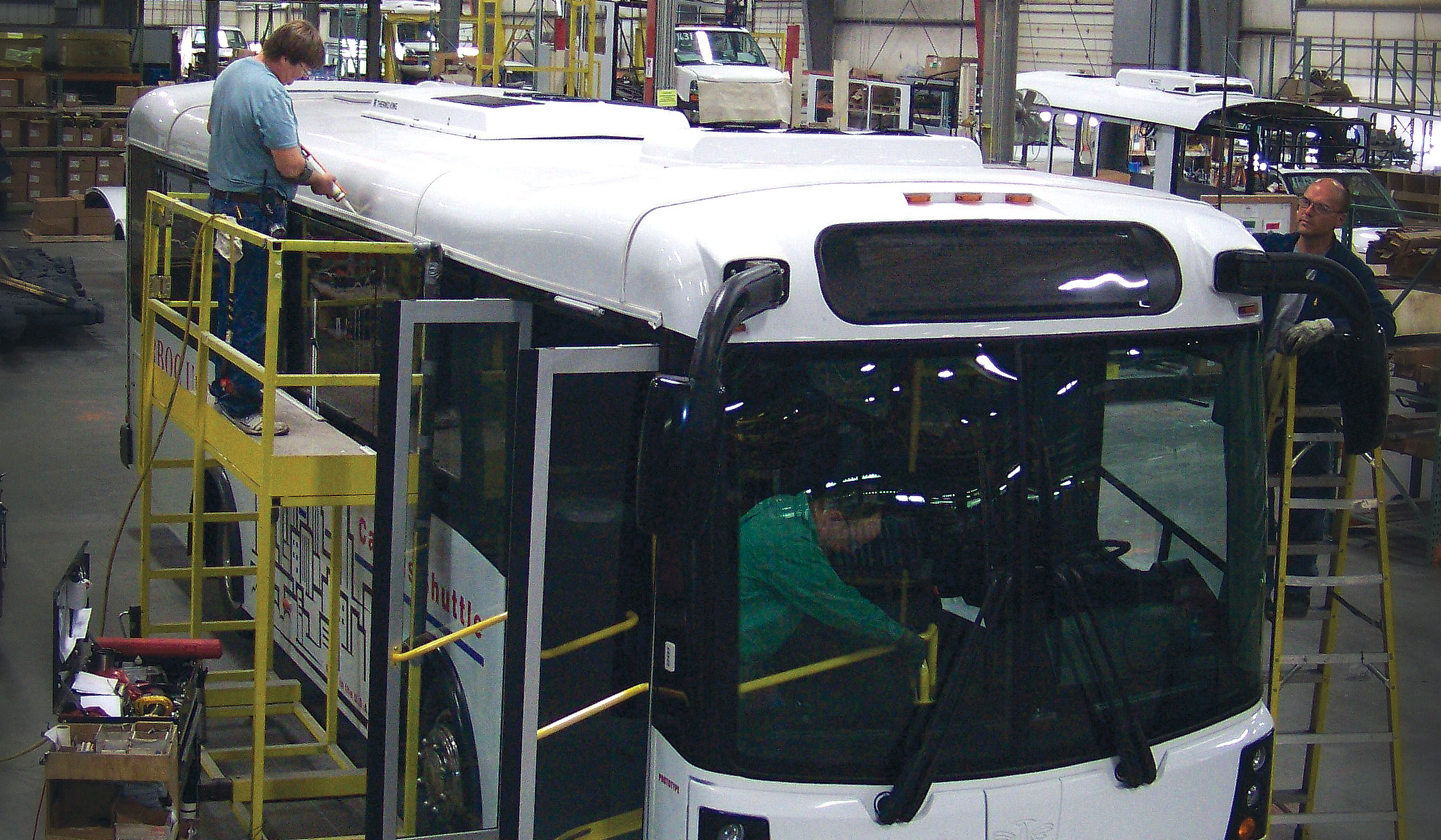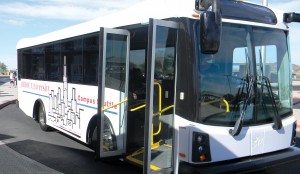
ARBOC Specialty Vehicles achieves its goal of a rear-drive, low-floor pusher
By David Hubbard
According to Don W. Roberts, president and CEO of ARBOC Specialty Vehicles, Middlebury, IN, with the launch of the Spirit of Liberty, the company will successfully meet the challenge it undertook several years ago to develop a rear-drive, low-floor pusher bus with a continuous flat floor from front to rear designed by Jim Bartel, co-founder of ARBOC.
ARBOC sent the Liberty prototype on a demo tour late last year, visiting major bus dealerships and transit agencies throughout the U.S. and Canada. With its bent for innovative engineering and design, the intent of these stops was to demonstrate the advantageous features and functions of the Liberty in the appropriate transit, shuttle and circulator applications.
“Before we sent the Liberty on its rounds, we made it very clear to the operators that they would be sampling only the prototype in terms of its innovative rear-engine drive, accessibility and ease of operation for drivers and technicians,” Roberts says. “We wanted everyone to understand that these demonstrations were not intended as the typical drive and ride tests of the final product.”
Through their exclusive collaborative agreement, ARBOC and Freightliner Custom Chassis Corporation (FCCC), Gaffney, SC, have engineered a number of enhancements to the Liberty that the company says will provide customers with a smooth handling and easily maintained vehicle.
Roberts says the company had in fact already anticipated what the comments might be, and was working closely with FCCC to fit the Reyco Granning suspension system with the Detroit rear-axle and the Meritor front-axle to achieve superior vehicle handling. The FCCC chassis also will come equipped with Sachs shocks as standard equipment.

With the demo tour in full force, Roberts and his team were at work finalizing the list of enhancements, mentioned here in part, that will appear on the full production Spirit of Liberty.
Liberty in action
With that said, BUSRide caught up with ARBOC in Coolidge, AZ, where Central Arizona Regional Transit (CART) was assessing the Liberty in actual transit service. Creative Bus Sales, Phoenix, AZ, arranged the road test. Transit Sales Representative Marcus Hoffman, who recently moved to Creative Bus Sales from his position as Section 5311 transit manager for the City of Coolidge, was instrumental in establishing the Pinal Central Express regional service route.
In this region of Arizona between Phoenix and Tucson, the three major communities are Casa Grande, Coolidge and Florence, as well as Central Arizona Community College. CART serves as the fixed-route connector on two routes, east and west from Coolidge, for employment, medical and personal travel. Together, the City of Coolidge Cotton Express and CART run a mixed fleet of nine cutaway buses that include three ARBOC Spirit of Mobility models.
City of Coolidge Transit Manager Michael Meyer says CART was very interested in testing this new model for consideration in a future procurement. On this day following the morning runs, Meyer took his turn at the wheel of the Liberty for the first time since the bus arrived at the transit center.
Meyer says he is especially interested in the ARBOC low-floor concept for its time saving benefits, noting that the people living in this part of Arizona routinely travel and commute significant distances to their places of employment and personal business.
Mornings and evenings are the peak runs, requiring higher capacity buses to accommodate more passengers and leave ample room for wheelchair riders and the occasional standees.
Available in three models, 29, 31 and 34 feet in length, the Liberty will accommodate up to 37 passengers and 14 standees.

“Transit service to and from these communities is all about saving time for the passengers and the agency,” Meyer says. “If their bus ride takes 15 minutes longer than the normal one-hour commute, they are less likely to use our service. We need to do everything we can to narrow the window and tighten the headway.”
All passengers enter on a 41-inch wide, 1:6 ramp by either Ricon or Braun. The low floor slopes two degrees front to back with theater seating with no step over the rear axle and a clear 39-inch pass between the wheel wells.
With Freedman folding seats, the Liberty provides standard 54- to 60-inch wheelchair spaces and up to six positions with the latest Q’Straint securement devices.
“The ramp ratio, low floor and wide entrance make boarding and de-boarding so much easier for everyone,” Meyer says. “Our wheelchair passengers enjoy the freedom. They appreciate not having to rely on a conventional lift at the rear of a bus.”
Aessa, a special needs customer who has depended on CART service for years and counts the drivers and regular passengers as close friends, was very receptive to the new bus on her route as Meyer wheeled her over the ramp and into position.
“This is so much nicer,” she said. “It feels wonderful to have this much space”.
Following the 30-minute route from Coolidge to Florence, Meyer offered his comments.
“With the rear engine, the Liberty has great power,” he says. “I realize this is a prototype, but it seems easy to operate and maintain. It is convenient for customers, as well as for the technicians pulling maintenance. They will appreciate the easy access to the engine and all the other components. Also, the one-piece floor is very easy to clean.”
Meyer says he and his team are very anxious to see the final production model.
In addition to the Freightliner chassis and suspension, he and the rest of the industry can expect to see other noteworthy enhancements.
ARBOC says it is currently redesigning the front and rear-floor to soft mount these assemblies, which will reduce the sound and vibration transmitted into the vehicle compartment and soften the ride of the vehicle.
To save weight, the engine coolant package, a mechanical drive system, now fits into to the lower rear roadside corner to facilitate the use of a smaller cooling package. Positioned for easy access, the coolant reservoir is located immediately over the rear of the engine.
With the new placement of the cooling package, a redesign of the rear fiberglass cap was necessary. The rear doors to the engine compartment are butterfly-style for safe access to the engine compartment. The right-hand door opens curbside to expose all the routine service and maintenance points. The left-hand door opens in the same manner to allow easy access for routine maintenance. The engine shuts off automatically any time the left-hand engine compartment door opens.
The 70-gallon fuel tank is situated in front of the rear drive-axle, which helps move the weight toward the front of the bus. The chassis rails also now protect the fuel tank from side impacts.
FCCC relocated the batteries and associated components to the passenger rear compartment, which also houses the fuel/water separator, a Schrader valve to fill the air suspension system in emergency cases, the airlift control module, product data management (PDM) and master electrical shut-off switch.
FCCC also redesigned the forward firewall assembly to incorporate a permanent mount for the master cylinder and steering wheel assembly. The DEF tank has been moved rearward of the road-side drive-axle tire, which is in keeping with the preferred location for most municipalities and service technicians.
ARBOC has modified the vehicle compartment window to shorten the former 45-inch length. All compartment windows are now 36 by 36 inches, allowing the option of thermo pane windows.
ARBOC says the Liberty will come with a roof-mount air conditioning system only.
“We we have not conducted an actual life cycle cost,” Roberts says. “However, we estimate it will show a 25 percent residual cost savings when compared to a 10-year 35-foot bus.”
